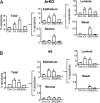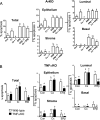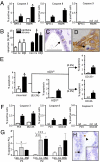Estrogen receptor-beta activated apoptosis in benign hyperplasia and cancer of the prostate is androgen independent and TNFalpha mediated
- PMID: 20133657
- PMCID: PMC2840300
- DOI: 10.1073/pnas.0905524107
Estrogen receptor-beta activated apoptosis in benign hyperplasia and cancer of the prostate is androgen independent and TNFalpha mediated
Abstract
Prostate cancer (PCa) and benign prostatic hyperplasia (BPH) are androgen-dependent diseases commonly treated by inhibiting androgen action. However, androgen ablation or castration fail to target androgen-independent cells implicated in disease etiology and recurrence. Mechanistically different to castration, this study shows beneficial proapoptotic actions of estrogen receptor-beta (ERbeta) in BPH and PCa. ERbeta agonist induces apoptosis in prostatic stromal, luminal and castrate-resistant basal epithelial cells of estrogen-deficient aromatase knock-out mice. This occurs via extrinsic (caspase-8) pathways, without reducing serum hormones, and perturbs the regenerative capacity of the epithelium. TNFalpha knock-out mice fail to respond to ERbeta agonist, demonstrating the requirement for TNFalpha signaling. In human tissues, ERbeta agonist induces apoptosis in stroma and epithelium of xenografted BPH specimens, including in the CD133(+) enriched putative stem/progenitor cells isolated from BPH-1 cells in vitro. In PCa, ERbeta causes apoptosis in Gleason Grade 7 xenografted tissues and androgen-independent cells lines (PC3 and DU145) via caspase-8. These data provide evidence of the beneficial effects of ERbeta agonist on epithelium and stroma of BPH, as well as androgen-independent tumor cells implicated in recurrent disease. Our data are indicative of the therapeutic potential of ERbeta agonist for treatment of PCa and/or BPH with or without androgen withdrawal.
Conflict of interest statement
The authors declare no conflict of interest.
Figures




Similar articles
-
Essential role for estrogen receptor beta in stromal-epithelial regulation of prostatic hyperplasia.Endocrinology. 2007 Feb;148(2):566-74. doi: 10.1210/en.2006-0906. Epub 2006 Oct 26. Endocrinology. 2007. PMID: 17068134
-
Profile of cell proliferation and apoptosis activated by the intrinsic and extrinsic pathways in the prostate of aging rats.Prostate. 2017 Jun;77(9):937-948. doi: 10.1002/pros.23349. Prostate. 2017. PMID: 28480526
-
Estrogen receptor β and treatment with a phytoestrogen are associated with inhibition of nuclear translocation of EGFR in the prostate.Proc Natl Acad Sci U S A. 2021 Mar 30;118(13):e2011269118. doi: 10.1073/pnas.2011269118. Proc Natl Acad Sci U S A. 2021. PMID: 33771918 Free PMC article.
-
Progesterone receptor in the prostate: A potential suppressor for benign prostatic hyperplasia and prostate cancer.J Steroid Biochem Mol Biol. 2017 Feb;166:91-96. doi: 10.1016/j.jsbmb.2016.04.008. Epub 2016 Apr 25. J Steroid Biochem Mol Biol. 2017. PMID: 27125450 Review.
-
The role of Eralpha and ERbeta in the prostate: insights from genetic models and isoform-selective ligands.Ernst Schering Found Symp Proc. 2006;(1):131-47. doi: 10.1007/2789_2006_020. Ernst Schering Found Symp Proc. 2006. PMID: 17824175 Review.
Cited by
-
Preclinical models of prostate cancer - modelling androgen dependency and castration resistance in vitro, ex vivo and in vivo.Nat Rev Urol. 2023 Aug;20(8):480-493. doi: 10.1038/s41585-023-00726-1. Epub 2023 Feb 14. Nat Rev Urol. 2023. PMID: 36788359 Review.
-
Estrogen receptor β in Alzheimer's disease: From mechanisms to therapeutics.Ageing Res Rev. 2015 Nov;24(Pt B):178-90. doi: 10.1016/j.arr.2015.08.001. Epub 2015 Aug 22. Ageing Res Rev. 2015. PMID: 26307455 Free PMC article. Review.
-
Soy isoflavones and prostate cancer: a review of molecular mechanisms.J Steroid Biochem Mol Biol. 2014 Mar;140:116-32. doi: 10.1016/j.jsbmb.2013.12.010. Epub 2013 Dec 25. J Steroid Biochem Mol Biol. 2014. PMID: 24373791 Free PMC article. Review.
-
Androgens and estrogens in benign prostatic hyperplasia: past, present and future.Differentiation. 2011 Nov-Dec;82(4-5):184-99. doi: 10.1016/j.diff.2011.04.006. Epub 2011 May 26. Differentiation. 2011. PMID: 21620560 Free PMC article. Review.
-
Central role for PELP1 in nonandrogenic activation of the androgen receptor in prostate cancer.Mol Endocrinol. 2012 Apr;26(4):550-61. doi: 10.1210/me.2011-1101. Epub 2012 Mar 8. Mol Endocrinol. 2012. PMID: 22403175 Free PMC article.
References
-
- Wei J, Calhoun E, Jacobsen S. Benign prostatic hyperplasia. In: Litwin M, Saigal C, editors. Urologic Diseases in America. Bethesda, MD: National Institutes of Health; 2007. NIH Publication No. 07-5512.
-
- Penson D, Chan J. Prostate cancer. In: Litwin M, Saigal C, editors. Urologic Diseases in America. Bethesda, MD: National Institutes of Health; 2007. NIH Publication No. 07-5512.
-
- Locke JA, et al. Litwin M, Saigal C, editors. Androgen levels increase by intratumoral de novo steroidogenesis during progression of castration-resistant prostate cancer. Cancer Res. 2008;68:6407–6415. - PubMed
-
- Stone NN, Clejan SJ. Response of prostate volume, prostate-specific antigen, and testosterone to flutamide in men with benign prostatic hyperplasia. J Androl. 1991;12:376–380. - PubMed
-
- Klotz L, McNeill I, Fleshner N. A phase 1-2 trial of diethylstilbestrol plus low dose warfarin in advanced prostate carcinoma. J Urol. 1999;161:169–172. - PubMed
Publication types
MeSH terms
Substances
LinkOut - more resources
Full Text Sources
Medical
Molecular Biology Databases
Research Materials

